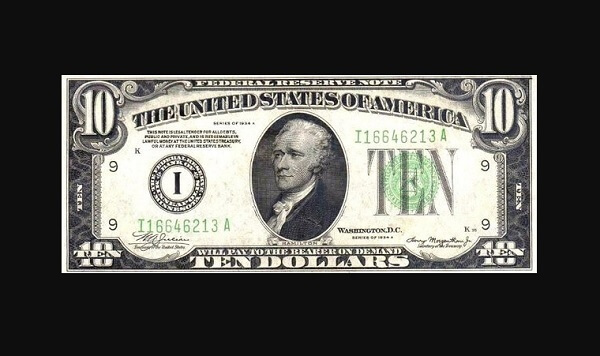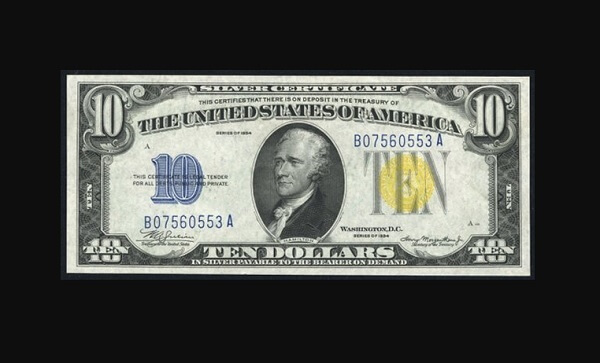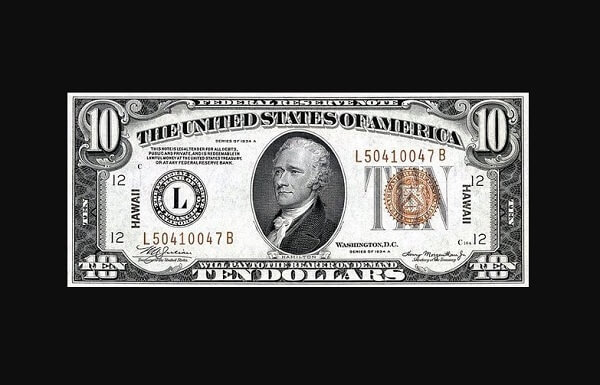1934 10 Dollar Bill Value – Have you ever come across a 1934 $10 bill and wondered how much it was worth? The value of a 1934 10-dollar bill has been a mystery to many, with some believing it to be worth a fortune while others dismiss it as just another old banknote.
However, the truth behind the 1934 $10 bill value is finally being revealed.
In this blog post, we will discuss the history and unique features of this particular banknote to uncover its true value and what makes it so sought after by collectors.
The 1934 10-dollar bill is a Federal Reserve note with a green seal. It’s different than the 1934 10-dollar silver certificate which has a blue seal. This Federal Reserve note is common, but if you have a star variety or a Hawaii overprint note then it could be valuable.
Keep reading to learn more about this bill and the different series.

The History and Significance of The 1934 $10 Bill
The history of the 1934 $10 bill is a fascinating one, filled with unique features and interesting stories. This bill, featuring Alexander Hamilton in the portrait, holds a significant place in American currency.
While the standard bills may not be worth much, there are certain varieties and series that have caught the attention of collectors and enthusiasts.
From the different seal varieties, such as the light green seals (LGS) and the darker blue-green seals, to the rare star notes and the Hawaii overprint notes, each one tells a story and holds its own value.
1934 10 Dollar Bill Specifications
The 1934 10-dollar bill holds a special place in American currency, with its unique features and historical significance.
This Federal Reserve note, featuring Alexander Hamilton on the portrait, comes in five different series: 1934, 1934A, 1934B, 1934C, and 1934D.
The denomination is $10.00 USD.
Each carries the iconic image of Hamilton, one of America’s founding fathers. Understanding the different series and their specifications is essential to accurately identifying and valuing your 1934 10-dollar bill.
How Much is a 1934 10 Dollar Bill Worth?
The value of a 1934 10-dollar bill may not be as high as you’d hope. Because these bills are quite common, most circulated ones are only worth their face value of $10. However, if you happen to have a bill in very fine condition or better, it can fetch a premium price.
Additionally, star notes, which have a star symbol at the end of the serial number, are also more valuable.
When it comes to the different seal varieties, the light green seals (LGS) tend to be worth more than the darker blue-green seals.

- A 1934 series $10 bill with a light green seal can be valued at around $20-35 in very fine condition and around $100-150 in uncirculated condition with an MS 63 grade.
- On the other hand, a bill with a darker blue-green seal may be worth around $15-23 in very fine condition and around $55-85 in uncirculated condition with an MS 63 grade.
Even bills starting with five zeros can have a small premium. To protect valuable bills, it’s recommended to place them inside currency holders.
1934 10 Dollar Bill Star Notes
Star notes are more rare and thus worth more money. They are overprinted notes that have a star symbol at the end of the serial number.
- Have a 1934 series $ 10-star note with a light green seal (LGS), it could be worth around $150-200 in very fine condition. In uncirculated condition, the price can range from $950-1,250 for bills with an MS 63 grade.
- On the other hand, if you have a 1934 series $ 10-star note with a darker blue-green seal, it may be worth around $80-125 in very fine condition and around $400-900 in uncirculated condition with an MS 63 grade.
The exact price in uncirculated condition will depend on the issuing bank.
Additionally, most 1934A series’ $ 10-star notes are worth around $40-75 in very fine condition and around $250 in uncirculated condition with an MS 63 grade.
However, notes issued from the Federal Reserve Bank of Boston will be worth less money, while notes issued from the Federal Reserve Bank of Minneapolis will be worth more money.
The 1934B series’ $ 10-star notes are worth around $75-125 in very fine condition and around $400-950 in uncirculated condition with an MS 63 grade.
The exact price in uncirculated condition will depend on the issuing bank.
The 1934C series $ 10-star notes are worth around $55-67.50 in very fine condition and around $250-750 in uncirculated condition with an MS 63 grade. Again, the exact price in uncirculated condition will depend on the issuing bank.
Most 1934D series $ 10-star notes are worth around $55-65 in very fine condition and around $400-550 in uncirculated condition with an MS 63 grade. However, notes issued from the Federal Reserve Banks of Richmond, St. Louis, Minneapolis, Kansas City, Dallas, and San Francisco will be worth more money.
So, if you have any of these star notes lying around, make sure to check their value and potential worth. You could be holding onto something valuable!
1934 10 Dollar Hawaii Note
During WWII, the US government introduced the 1934A series $10 Hawaii notes as a precautionary measure in case Japan took over Hawaii.
These notes, also known as Hawaii notes, are distinct from the standard 1934 bills with their brown seals and a Hawaii label. If Japan had gained control of Hawaii’s money supply, these notes would have become instantly worthless.

Today, the 1934A $10 Hawaii notes hold some value for collectors.
- In very fine condition, they are worth approximately $125, while in uncirculated condition with an MS 63 grade, their price can go up to around $750.
- However, if you happen to come across a 1934A $10 Hawaii star note, its value increases significantly.
- In very fine condition, it can be worth around $700, and in uncirculated condition with an MS 63 grade, its price can skyrocket to approximately $11,500.
So, if you’re lucky enough to find one of these rare Hawaii notes, hold onto it as it could be a valuable addition to your collection.
1934 10 Dollar Bill Grading System
The grading system for a 1934 10-dollar bill is essential for determining its value and condition.
- A note that is categorized as “very fine” has been in circulation but not for a long time. It still retains its crispness, although there may be some creases, folds, or light smudges.
- On the other hand, an “MS 63 choice uncirculated” note shows no signs of ever having been in circulation. It maintains its original crispness and is well-centered.
Understanding the grading system is crucial for accurately assessing the condition of your bill and ultimately determining its worth.
How to Preserve and Protect Your Old Currency for Potential Value Increase
As you’ve learned about the value and unique features of the 1934 $10 bill, you may be wondering how to preserve and protect your old currency for potential value increase.
- Ensure that your bills are stored in currency holders, which offer protection from environmental damage and potential mishandling.
- Avoid exposing your bills to direct sunlight or extreme temperature fluctuations, as these can cause fading and deterioration.
- Be cautious of handling your bills with dirty or oily hands, as this can leave permanent marks.
- Consider researching serial number lookup resources to determine if your bill holds any unique or valuable characteristics.
By following these tips, you can safeguard your old currency and potentially increase its value in the future.
Conclusion
After diving into the history, unique features, and value of the 1934 $10 bill, it is clear that not all bills are created equal. While the standard bills are not worth much, there are certain varieties and series that can fetch a premium price.
From the star notes to the Hawaii overprint notes, collectors and enthusiasts are constantly on the lookout for these rare finds.
So, if you happen to come across a 1934 $10 bill, make sure to check its characteristics and potential worth. You never know, you could be holding onto a valuable piece of currency. Remember, valuable bills should always be stored properly to maintain their condition and potential value increase. Happy collecting!
See Also About Other $10 Bills: